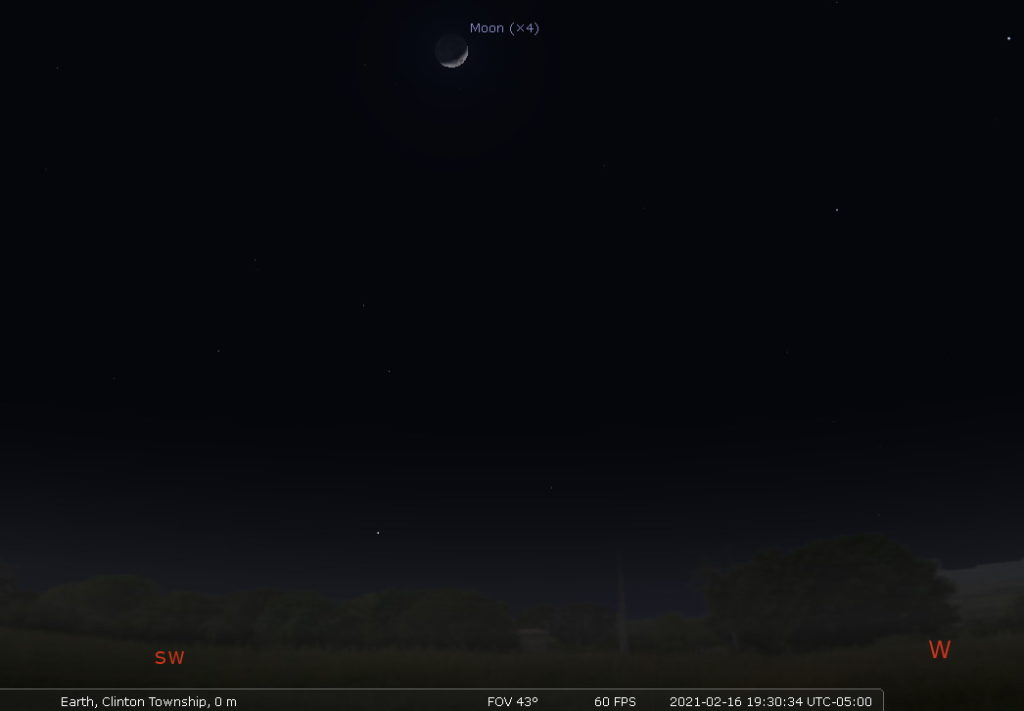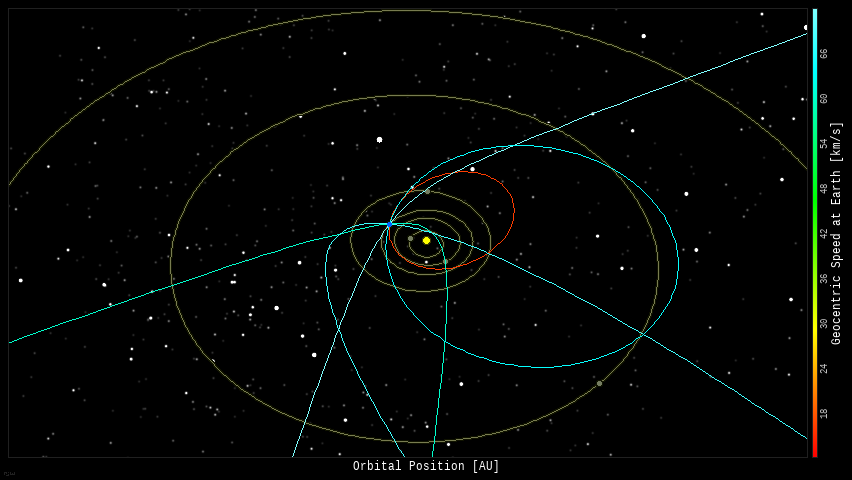NASA’s Mars 2020 Perseverance rover lands on Thursday Feb. 18th, and NASA is inviting the public to take part in virtual activities and events as the rover nears entry, descent, and landing. Touchdown on Mars is scheduled for approximately 3:55 p.m. EST Thursday! This will be the second landing on Mars using the sky crane maneuver to lower the heavy rover down to the surface.


The waxing crescent Moon appears high in the west-southwestern sky after sunset on Feb. 16th.

The Moon appears near Mars high in the southern sky after sunset on Feb. 18th, then by the star Aldebaran on Feb. 19th and 20th.
Mercury and Saturn appear low above the east-southeastern horizon before dawn this week; by early next week those two planets will be a bit higher above the horizon, and Jupiter will join them.
In a previous post, I wondered if a space telescope observing the Sun would catch a glimpse of these planets… sure did!

The Moon is a waxing crescent – visible to the southwest in the early evening.
The first quarter Moon occurs on Feb. 19th – visible high in the southern sky in early evening.
After Feb. 19th, the Moon will be a waxing gibbous – visible to the southeast in early evening, and up for most of the night.

If you click on the Moon image above, or click this link, you will go to NASA’s Moon Phase and Libration, 2021 page – it will show you what the Moon looks like right now. If you click the image on that page, you will download a high-rez TIFF image annotated with the names of prominent features – helpful for logging your lunar observations!
Moon News – Awwwwwwwwww
 The Sun has been spotless for 12 days – that would mean that the “small, as-of-yet unnamed, sunspot rotating into view” from last week faded, and was not named.
The Sun has been spotless for 12 days – that would mean that the “small, as-of-yet unnamed, sunspot rotating into view” from last week faded, and was not named.
The southern coronal hole remains huge, the northern coronal hole is medium-sized with a large tendril stretching down towards the equator; a large coronal hole is rotating into view (left).
The Sun seen in 193 angstroms (extreme ultraviolet) February 15, 2021:
A couple long-lived prominences, with several short-lived prominences popping up all around the limb of the Sun over the last couple days.
The Sun seen in 304 angstroms (extreme ultraviolet) February 15, 2021:
You can view the Sun in near real-time, in multiple frequencies here: SDO-The Sun Now.
You can create your own time-lapse movies of the Sun here: AIA/HMI Browse Data.
You can browse all the SDO images of the Sun from 2010 to the present here: Browse SDO archive.
Solar Activity on Facebook – Run by Volunteer NASA/JPL Solar System Ambassador Pamela Shivak

Solar Corona
Solar wind speed is 360.5 km/sec, with a density of 15.4 protons/cm3 at 1120 UT.
Near real-time animation of the corona and solar wind from the Solar & Heliospheric Observatory (SOHO):

Sun News: Animation of Cosmic Rays and the Heliopause
This animation shows how variations in the size of the heliosphere affect how many cosmic rays reach Earth. As the heliosphere expands, it blocks more cosmic rays, and as it contracts, more cosmic rays get through and can affect astronauts and satellites. – NASA

Potentially hazardous asteroids: 2170 (updated 2021-02-16)
Total Minor Planets discovered (NASA): 1,059,992 (+11,666)
Total Minor Planets discovered (MPC): 1,026,572 (This value has not been updated in months)
Upcoming Earth-asteroid encounters:
| Asteroid |
Date(UT)
|
Miss Distance
|
Velocity (km/s)
|
Diameter (m)
|
| 2021 BS3 |
2021-Feb-16
|
17.3 LD
|
10.4
|
63
|
| 2021 CZ7 |
2021-Feb-16
|
3.2 LD
|
9.2
|
8
|
| 2021 BM |
2021-Feb-17
|
6 LD
|
2.9
|
31
|
| 2021 CH5 |
2021-Feb-17
|
12.2 LD
|
9
|
16
|
| 2021 CD5 |
2021-Feb-18
|
12 LD
|
14.9
|
26
|
| 2020 CX1 |
2021-Feb-18
|
4.9 LD
|
8.3
|
56
|
| 2021 CM1 |
2021-Feb-18
|
18.2 LD
|
6.4
|
27
|
| 2021 CU8 |
2021-Feb-18
|
3.1 LD
|
12.7
|
7
|
| 2021 CE8 |
2021-Feb-19
|
7.5 LD
|
12.2
|
9
|
| 2021 CP7 |
2021-Feb-19
|
6.3 LD
|
10.4
|
9
|
| 2021 CB8 |
2021-Feb-19
|
8.3 LD
|
11.4
|
10
|
| 2021 CO4 |
2021-Feb-19
|
15.8 LD
|
19.1
|
59
|
| 2021 CW2 |
2021-Feb-19
|
12.3 LD
|
3.8
|
10
|
| 2021 CU3 |
2021-Feb-20
|
16.1 LD
|
25.9
|
98
|
| 2021 CC2 |
2021-Feb-20
|
16.5 LD
|
4.4
|
94
|
| 2021 CR3 |
2021-Feb-20
|
19 LD
|
23
|
106
|
| 2020 BV9 |
2021-Feb-22
|
14.7 LD
|
7.6
|
25
|
| 2020 XU6 |
2021-Feb-22
|
10.7 LD
|
8.4
|
222
|
| 2021 CC5 |
2021-Feb-22
|
18.1 LD
|
10.4
|
44
|
| 2015 EQ |
2021-Feb-23
|
18 LD
|
10.5
|
21
|
| 2021 CH8 |
2021-Feb-23
|
13 LD
|
9.8
|
38
|
| 2011 DW |
2021-Mar-01
|
13.9 LD
|
13.6
|
89
|
| 2011 EH17 |
2021-Mar-02
|
9.6 LD
|
16.8
|
43
|
| 2016 DV1 |
2021-Mar-02
|
3.9 LD
|
18.4
|
39
|
| 1999 RM45 |
2021-Mar-02
|
7.7 LD
|
20
|
468
|
| 2020 SP |
2021-Mar-03
|
18.4 LD
|
3.9
|
14
|
| 2021 CN3 |
2021-Mar-05
|
11.2 LD
|
3.8
|
18
|
| 2021 CF8 |
2021-Mar-05
|
11.6 LD
|
11.9
|
53
|
| 535844 |
2021-Mar-10
|
14.2 LD
|
7.3
|
162
|
| 2021 CF6 |
2021-Mar-10
|
4.2 LD
|
8.4
|
64
|
| 2020 FM |
2021-Mar-10
|
18.2 LD
|
13.3
|
57
|
| 2011 YW10 |
2021-Mar-12
|
19.8 LD
|
13.2
|
45
|
| 2021 CX8 |
2021-Mar-15
|
18.2 LD
|
6.6
|
50
|
| 231937 |
2021-Mar-21
|
5.3 LD
|
34.4
|
1024
|
| 2021 CX5 |
2021-Mar-27
|
7.7 LD
|
5.6
|
49
|
| 2020 GE |
2021-Mar-27
|
12.7 LD
|
1.5
|
8
|
| 2019 GM1 |
2021-Mar-31
|
15.1 LD
|
3.9
|
14
|
| 2015 MB54 |
2021-Apr-06
|
13.6 LD
|
3.7
|
59
|
| 2020 GE1 |
2021-Apr-07
|
12.2 LD
|
4.2
|
14
|
| 2014 FO38 |
2021-Apr-07
|
16.8 LD
|
8.3
|
20
|
| 2020 UY1 |
2021-Apr-15
|
16 LD
|
8.7
|
22
|
Notes: LD means “Lunar Distance.” 1 LD = 384,401 km, the distance between Earth and the Moon. Red highlighted entries are asteroids that either pass very close, or very large with high relative velocities to the Earth. Table from SpaceWeather.com
Asteroid News: Remember Chelyabinsk! 2013-02-15.
 On February 15, 2021, the NASA All Sky Fireball Network reported 6 fireballs!
On February 15, 2021, the NASA All Sky Fireball Network reported 6 fireballs!
(6 sporadics)

Fireball News
If you see a bright meteor or a fireball, please REPORT IT to the American Meteor Society and the International Meteor Organization!
 Position of the planets and several spacecraft in the inner solar system:
Position of the planets and several spacecraft in the inner solar system:

The Parker Solar Probe will fly-by Venus on Feb. 20th:

Orbit of NASA’s Perseverance Mars Rover as it approaches Mars; the rover is getting close enough to Mars the the orbits of other spacecraft around Mars have started to resolve in the NASA Eyes app.

Credit: Bob Trembley / NASA Eyes on the Solar System.
Position of the planets in the middle solar system:

Position of the planets, dwarf planets and some transneptunian objects in the outer solar system:


Mars Perseverance Rover: #CountdownToMars
Reminder: Check out NASA’s M2020 EDL simulation!! https://eyes.nasa.gov/apps/mars2020/
International Space Station:
HiRISE – on the Mars Reconnaissance Orbiter:
Spacecraft named after Katherine Johnson: #Cygnus
Hubble Space Telescope:
Climate:
See a list of current NASA missions here: https://www.jpl.nasa.gov/missions/?type=current

ex·o·plan·et /ˈeksōˌplanət/, noun: a planet orbiting a star other than the Sun.
Data from the NASA Exoplanet Archive
* Confirmed Planets Discovered by TESS refers to the number planets that have been published in the refereed astronomical literature.
* TESS Project Candidates refers to the total number of transit-like events that appear to be astrophysical in origin, including false positives as identified by the TESS Project.
* TESS Project Candidates Yet To Be Confirmed refers to the number of TESS Project Candidates that have not yet been dispositioned as a Confirmed Planet or False Positive.
Exoplanet News


SpaceWeather.com Realtime Aurora Gallery: https://spaceweathergallery.com/aurora_gallery.html
Visit an International Dark Sky Park: https://www.darksky.org/our-work/conservation/idsp/parks/
For Students:
Hubble: Beautiful Universe

This image from the NASA/ESA Hubble Space Telescope features an impressive portrait of M1-63, a beautifully captured example of a bipolar planetary nebula located in the constellation of Scutum (the Shield). A nebula like this one is formed when the star at its center sheds huge quantities of material from its outer layers, leaving behind a spectacular cloud of gas and dust.
It is believed that a binary system of stars at the center of the bipolar nebula is capable of creating hourglass or butterfly-like shapes like the one in this image. This is because the material from the shedding star is funneled toward its poles, with the help of the companion, creating the distinctive double-lobed structure seen in nebulae such as M1-63. – NASA.
SpaceEngine Work in Progress – 3D Rings using Raymarching:
What I was listening to while writing this post:
Cover Image: Artist’s illustration of Mars Perseverance descent to Mars, the spacecraft containing NASA’s Perseverance rover slows down using the drag generated by its motion in the Martian atmosphere. Hundreds of critical events must execute perfectly and exactly on time for the rover to land on Mars safely on Feb. 18, 2021. Credit: NASA/JPL-Caltech.
Stay safe, be well, and look up!
Software Apps used for this post:
NASA Eyes on the Solar System: an immersive 3D solar system and space mission simulator – free for the PC /MAC. I maintain the unofficial NASA Eyes Facebook page.
Universe Sandbox: a space simulator that merges real-time gravity, climate, collision, and material interactions to reveal the beauty of our universe and the fragility of our planet. Includes VR support.
SpaceEngine: a free 3D Universe Simulator for Windows. Steam version with VR support available.
Stellarium: a free open source planetarium app for PC/MAC/Linux. It’s a great tool for planning observing sessions. A web-based version of Stellarium is also available.
Section header image credits:
The Sky – Stellarium / Bob Trembley
Observing Target – Turn Left at Orion / M. Skirvin
The Moon – NASA/JPL-Caltech
The Sun – NASA/JPL-Caltech
Asteroids – NASA/JPL-Caltech
Fireballs – Credited to YouTube
Comets – Comet P/Halley, March 8, 1986, W. Liller
The Solar System – NASA Eyes on the Solar System / Bob Trembley
Spacecraft News – NASA Eyes on the Solar System / Bob Trembley
Exoplanets – Space Engine / Bob Trembley
Light Pollution – NASA’s Black Marble
Aurora – Bob Trembley
The Universe – Universe Today




